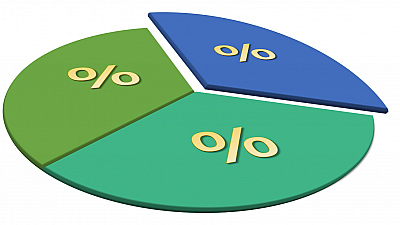Today, there are thousands of different cryptocurrencies with various functions and specifications. Basically, they can be divided into three types of cryptos.
BITCOIN
This is the first ever decentralized cryptocurrency. It is up to now the most popular and the most widely accepted coin. It is the largest cryptocurrency in value (or market cap), leading the second in the ranking with 10 times higher value.
Its story begins in 2008 when a person, or a group of people, using the name Satoshi Nakamoto, creates a “purely peer-to-peer version of electronic cash (allowing) online payments to be sent directly from one party to another without going through a financial institution”. Bitcoin is so successful that it is referred to as the Gold of cryptocurrencies.
Bitcoin uses blockchain to store and transfer data across participants. The blockchain is an immutable record of encrypted data managed by a cluster of computers. The information in the blockchain system is stored in a shared and continuously updated database, which has no physical single location. Every computer (node) has the same version of the database, meaning there are millions of copies. This gives a level of transparency never seen before in a financial system.
The blocks that contain the data are "produced" through a process, known as mining. This is a way to validate the data packed within the block. The usual size is 1 MB and it takes about 10 minutes to complete it. The information is encrypted using a hashing algorithm so sensitive, that even the slighest of change generates a completely different set of symbols.
Miners (the people who mine the blocks) are rewarded for their work with Bitcoin.This is the only way new BTC are generated. Their total number is capped and this is hard-coded into the blockchain. The supply is regulated through the Halvings that happen once every 210 000 blocks or approximately every 4 years. In these events the miners' reward is cut in half, thus reducing the generation rate of the crypto coins. In total 21 million coins will be mined by the year 2140.
Once all the blocks are mined and all the coins are created, transaction fees will pay miners for keeping the network going and secure. If the blockchain system develops well, the growing number of transactions will make up for the lack of new coins.
ALTCOINS
As the name suggests altcoins are alternatives to the original (Bitcoin). The first altcoins appeared in 2011 when Bitcoin users started noticing flaws in the Bitcoin system. The new solutions were designed for better speed, anonymity and security. Some of them are hard forks of Bitcoin, while others are completely new currencies with their own blockchains.
ETHEREUM
Ethereum is a programmable blockchain-based platform. This means that Smart contracts and Decentralized applications (DApps) can be built and deployed on top of the blockchain. The code written on the Ethereum blockchain can’t be altered, tempered, or hacked. The smart contracts and DApps are not managed or censored by any third party and run without any downtime.
It takes about 14 seconds to complete an Ethereum block and its size defers, depending on the complexity of the smart contracts in it. Most blocks are around 2 MB. This leads to a fast growing blockchain that, at one point, would become difficult to manage.
One proposed solution to the problem is called “Sharding”. This would divide the chain between groups of nodes and not everyone on the network would be verifying and recording everything.
The cryptocurrency asset Ethereum uses is Ether (ETH). This is the fuel to everything on the network. ETH is sought mostly by developers who need it to develop and run applications inside the platform, but there are other uses of it, too. ETH can be streamed to pay or receive funds in real-time or traded against other tokens.
At launching Ethereum, 72 million Ether were initially released and from there on 5 ETH are awarded for each new block. There is no cap to the amount of ETH that would be released, so theoretically it can go forever.
Some fear that at one point the supply would outgrow the demand and that might decrease the value of ETH. Others point out that as competition grows, the time it takes to solve a block would increase, thus decreasing the speed of new coin creation.
RIPPLE
Ripple is a global payment system that aims to replace the outdated systems for international payments that are both slow and expensive. It was developed by Ripple Labs Inc., a for-profit company.
Its structure is a bit different from the standard blockchain technologies. It uses a common ledger managed by validating servers. Those servers are permissioned and authorized by Ripple (the company) to confirm transactions and update the ledger. This means instantaneous validation at low cost for the users and less computing resources for the validating nodes.
XRP Ledger is designed to move large amounts, so it best serves the needs of banks and other financial institutions. This happens through the gateways of the RippleNet (a digital network based on the Ripple Transaction Protocol). RippleNet processes 1,500 transaction per second (compared to BTC – 6, ETH – 15). Each transaction is validated in 5 – 7 seconds. The platform hosts 3 different products: xCurrent (the primary product), xVia (a payment interface and suite of APIs) and xRapid (the liquidity solution).
The cryptocurrency of Ripple is XRP. It is not created through mining. Instead all coins were issued with the launch of the network. The total amount is 100 billion coins and according to Ripple protocol no more coins can ever be created. 41 billion XRP are currently in circulation, the rest is held by Ripple Labs.
Transactions are paid for using XRP, which is destroyed (burned) in the process. The Proof-of Burn consensus mechanism that is used means XRP supply will decrease over time. This might raise the XRP value in the future, compensating other factors that could keep it low.
TETHER
Tether is the most famous member of a group called “Stable coins”. They are designed to follow tightly the value of a fiat currency, like the US dollar. This pegging to the US dollar is achieved by maintaining dollar reserves amounting to the number of USDT in circulation. In other words, every USDT coin in the crypto market is backed by 1 USD (or EUR, for the EURT), as far as the company owning Tether claims.
Tether doesn’t have its own blockchain but operates on top of other cryptocurrencies’ blockchains (like Bitcoin and Ethereum, for example), using their security algorithms. There is no hard-coded limit on the total number of coins. It is rather a matter of company policy. According to Tether (the company) every time a coin is created, one dollar is put aside to ensure the coin is completely backed by cash.
To have a coin like USDT in the volatile crypto market is a great benefit. It builds a bridge between crypto and fiat currencies. Many crypto exchanges that do not deal in fiat money offer USDT in the trading pairs.
Tether is considered by some a safe haven, because in times of high volatility in the crypto markets they can keep their portfolios safe through Tether without having to completely cash out into USD.
There are many concerns, though, that need to be mentioned. One of the biggest is that the cryptocurrency is privately owned, so it’s completely centralized. Another big issue is a number of controversies regarding the validity of Tether’s claim about their USD reserves. Many fear that the company is not completely fair and transparent, considering the fact that the reserves have never been fully audited by an independent third party.
MONERO
The Monero blockchain is all about anonymity. Its cryptography obfuscates the sending and receiving addresses, as well as the transacted amounts. Security updates are often and mandatory (Hard forks) for the network. Monero is a private and secure system, where transactions are executed in a completely unlikable and untraceable way.
To ensure all of that, Monero uses rings of signatures and stealth addresses. Ring signatures are a way of concealing the sender.
In a nutshell, when sending XMR to someone, the sender would first choose a “ring size”. This means that the current transaction will be packed with several (the ring size) additional decoy transactions, pulled from the Monero network (executed valid entries, no permission is required from the participants involved). When signed and sent for validation, it is impossible to tell the true from the decoy transactions, and at the same time, it’s unambiguously recognizable to the validation algorithm (thanks to something, called “key image”).
The stealth addresses add to the opacity. The sent XMR do not directly go to the receiver’s wallet. Instead they are transferred to a one-time public address. The receiver then scans the network for this address and retrieves the coins.
Because every transaction is completely untraceable, along with the history of any one XMR coin, Monero is considered fungible. This means that there is no difference between the coins.
Monero blockchain uses the Proof-of-Work consensus protocol (like Bitcoin), but the algorithm aims to favor the use of consumer-grade PCs for mining, rather than large mining pools that use specialized, high-performance mining hardware. Despite that, a few mining pools have formed, that hold much of the hashing power.
The blocks don’t have a fixed size. When demand increases, the size of the blocks increases respectively. When it shrinks, the block size decreases as well. To prevent malicious activities, a median of the last one hundred block sizes is calculated and compared to the new block size. If it is bigger, miners get penalized through a reduced reward (the bigger the difference, the bigger the penalty).
A block is mined in about 2 minutes and the reward miners currently get is 4.99 XMR. The total amount of XMR is topped at 18.4 million Monero coins, though once reached there will be further creation of coins at a rate of 0.3 XMR/minute to ensure the miners rewards and to keep them incentivized to mine.
OTHER ALTCOINS
The list of altcoins goes on, of course. Some of them are quite successful, like Litecoin (the silver to Bitcoin’s gold), Dash, Zcash, EOS and more. Each has its own specifics but they all (altcoins and Bitcoin alike) serve a similar purpose – be an alternative to the old ways.
TOKENS
Tokens represent a tradable asset or utility. They are created in the context of a specific business idea and in order to have value, they need to be accepted by a community. Tokens are issued on top of an existing cryptocurrency blockchain, most often – the Ethereum blockchain, and cannot function on their own.
They are quite easy to make. Certain rules and pre-defined templates are to be followed to create a smart contract that would distribute tokens. A unified solution is the ERC-20 Token Standard. This is a protocol, or a step-by-step guide to lead you through the process.
Tokens are distributed in an Initial Coin Offering (ICO). While the ICO is active, the people interested in the project buy the tokens, usually paying with cryptocurrency coins. Tokens can be classified into two sections: security and utility tokens.
Security tokens represent a share in some external asset or enterprise. They are a subject to the same regulations as the standard stocks. Even though they are issued on a blockchain, they grant legal contract-binding ownership right over an asset to the investor.
Utility tokens are different. They grant the holder access to a future product or service, something like a pre-order. Utility tokens are a way to bypass traditional investors and raise funds directly from the future customers. They are not an investment in the developing business and do not grant any share of it.
Utility tokens can only be used within the issuing platform. A good example of utility tokens is those used in some gaming platforms. The tokens can be bought with crypto or fiat money and can be used within the game to purchase things or give them to other players. Utility tokens are a popular fundraising method and a good way of providing funds to innovative or interesting business ideas.




